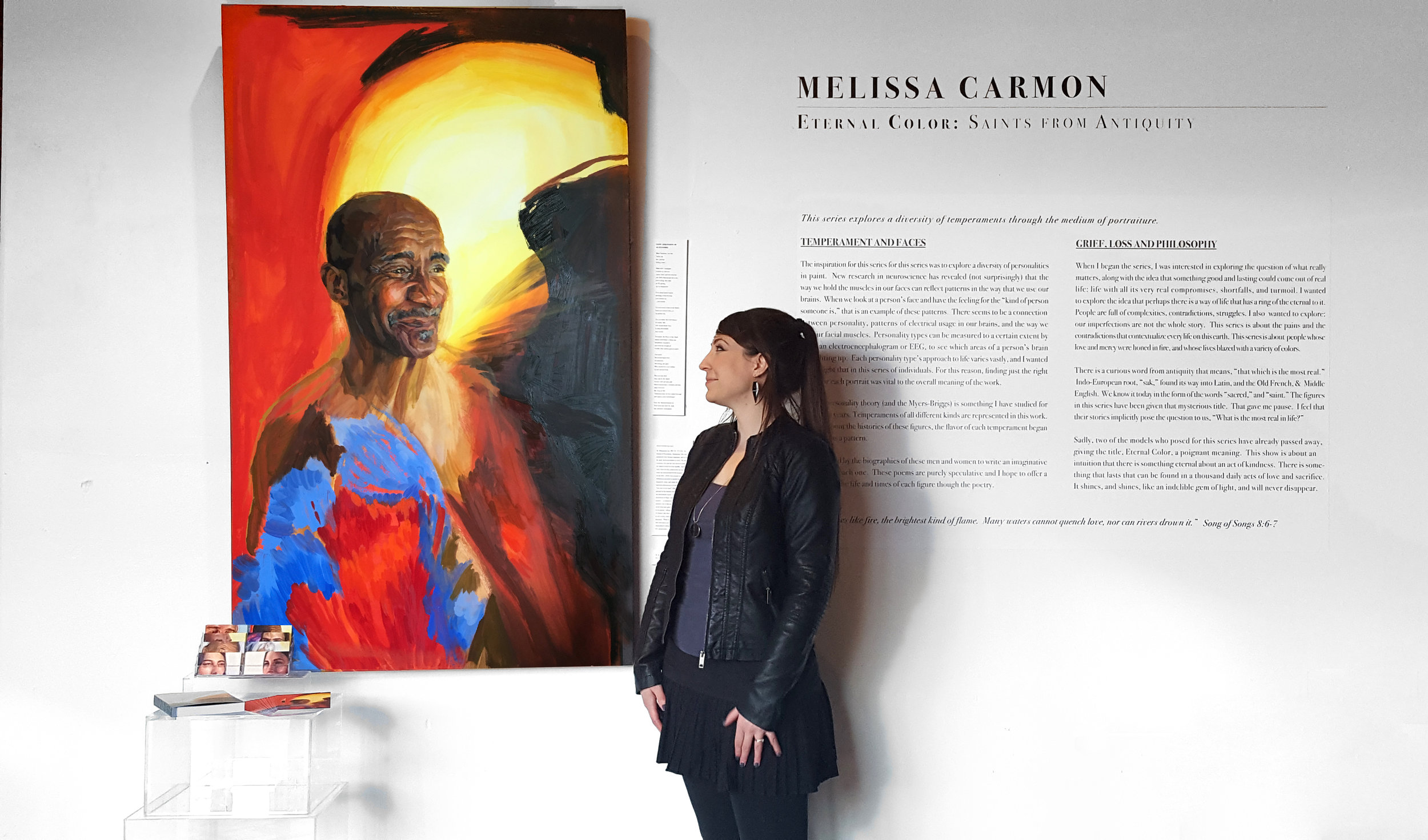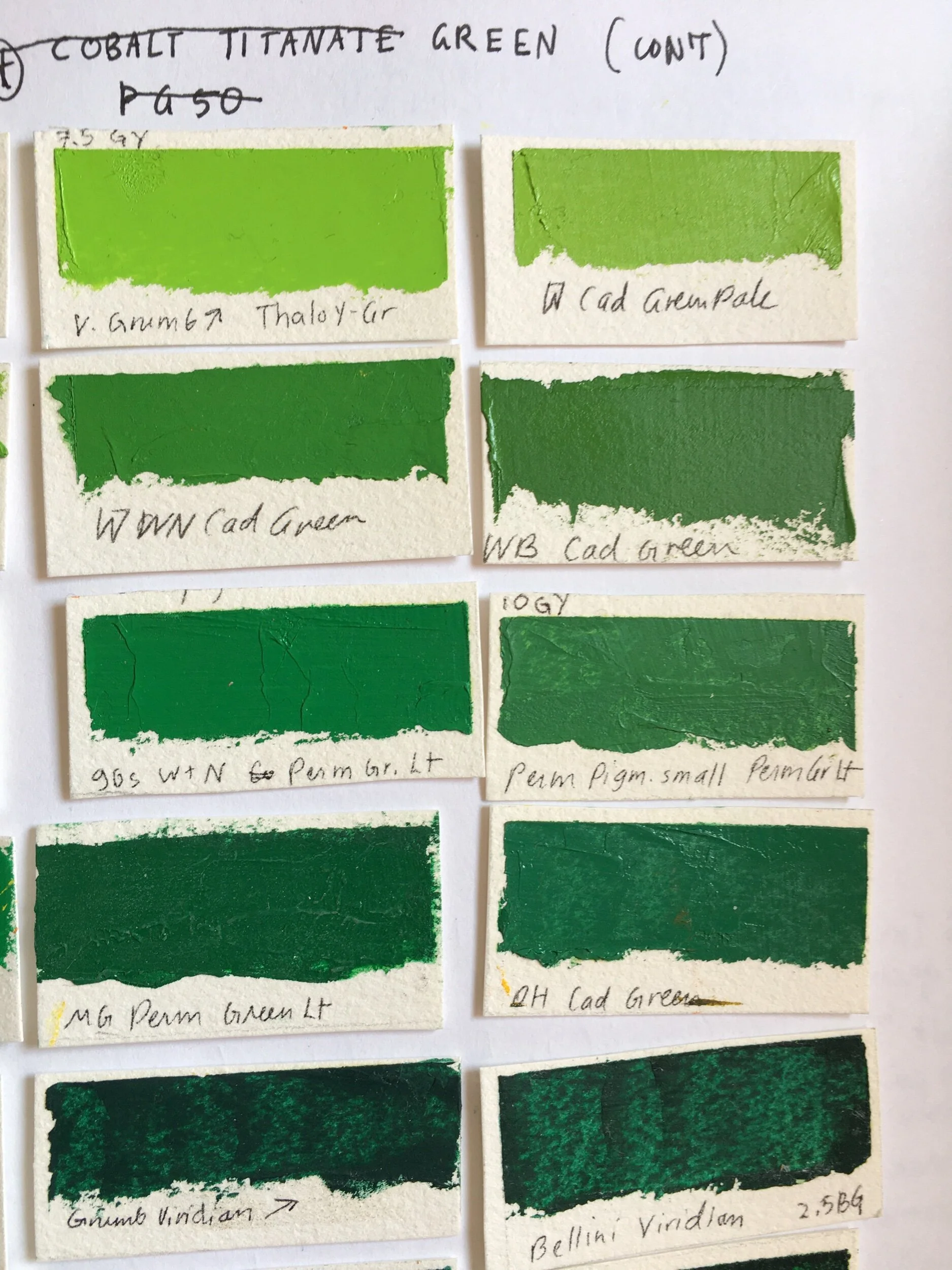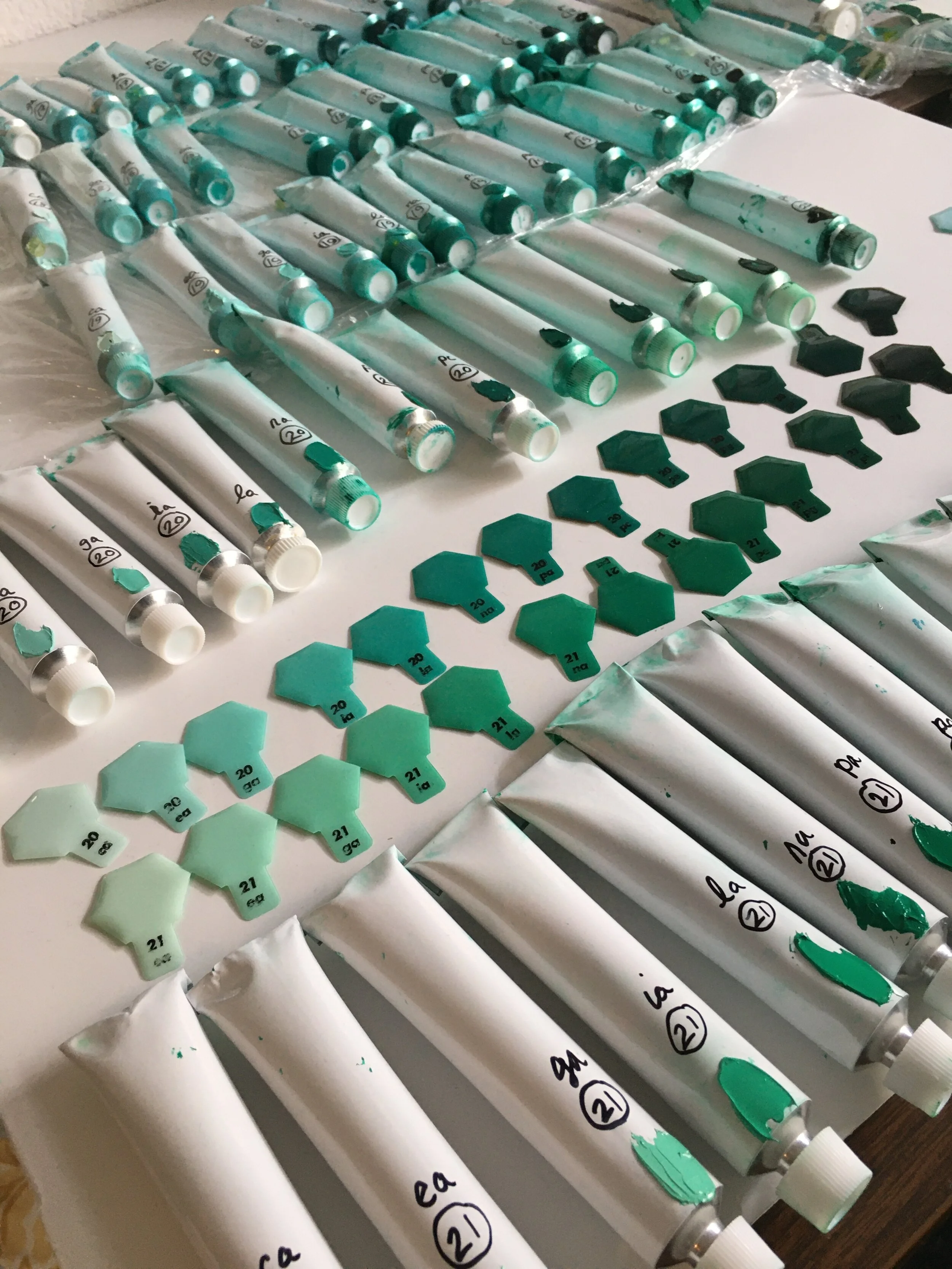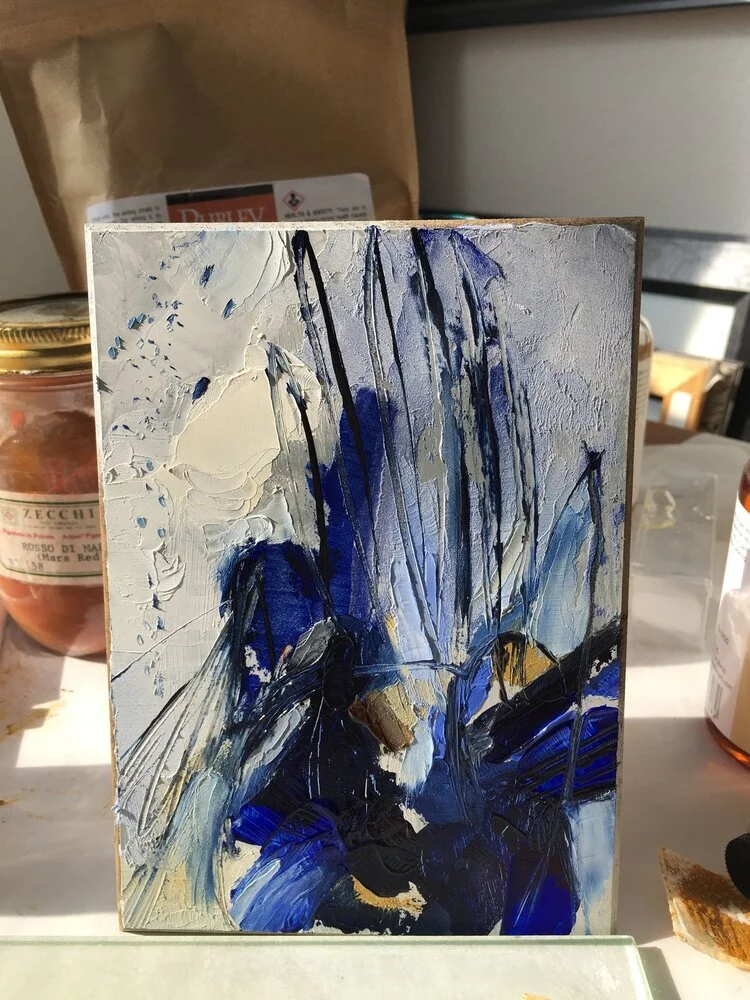Eternal Color Series -2021
EtERNAL COLOR: Portrait Series
Where history and legend meet, faces from the Eternal Color Series ask us to consider the question of the meaning of a life well lived
This series of 12 paintings explores the lives of early historical figures who were later bestowed the title of saint. A diversity of personalities is represented, and each one honors a different way of contributing to the world. Each person selected for this series made a contribution to the development of culture. The work of several of them significantly shaped the world as we know it.
A short video about the linguistic link that inspired the series
Each painting is accompanied by a poem about the figure, and historical information.
During a recent exhibition, the Inspire Duo, a group of award winning musicians created musical arrangements for each figure, and interpreted the art musically.
Each piece measures 60” x 35” and is painted with oil on panel. The underpainting for each painting was made with acrylic, with oil painted on top. There are textural accents with R&F pigment stick, which is like oil paint, and contains more wax.
portraits
from the Eternal Color Series
The Sun, by Czeslaw Milosz
“All colors come from the sun. And it does not have
Any particular color, for it contains them all.
And the whole Earth is like a poem
While the sun above represents the artist.
Whoever wants to paint the variegated world
Let him never look straight up at the sun
Or he will lose the memory of things he has seen.
Only burning tears will stay in his eyes.
Let him kneel down, lower his face to the grass,
And look at the light reflected by the ground.
There he will find everything we have lost:
The stars and the roses, the dusks and the dawns.”
Warsaw, 1943
Where history and legend meet, faces of saints from the Eternal Color Series bring the distant past to life
This interdisciplinary series explores the lives and personalities of individuals who lived in Late Antiquity (around 300 CE to 600 CE)— a period of profound cultural change. The project brings together poetry, philosophy, history, psychology, and painting. All of the subjects featured in the paintings have a number of surprising qualities: each was given the title of “saint,” at some point in history, and each figure influenced the trajectory of western culture. Some of their voices still reverberate seventeen centuries later.
These 12 historical portraits are painted twice-life-sized (60” x 35”) in oil and acrylic on 5-foot tall panels. I composed a poem for each individual which distills the emotional impact of their historical context and biography. The 12 portraits were created between 2016 and 2018, with an opening show and concert performance in early 2019. For the show, I collaborated with a flute and piano duo who created musical compositions for each painting (see the next portfolio piece for more details about the exhibition).
SPARKED BY AN ANCIENT WORD
The series was inspired by the etiology of the word “saint,” which derives from a the Indo-European root wood, “sak,” meaning “that which is the most real.” This word, which is also the root of the word “sacred,”which entered the English language through Latin roots, has even more ancient ties to the Sanskrit language.
The philosophical question of what is the most real was something that I wanted to express visually. The series blends together realism with abstraction in a way that underwrites the lingering tension between the mundane and the sacred, the seen and the unseen, the physical and the immaterial, and the human and the divine.
INSPIRATION FROM THE SYMBOLISTS
A lengthy process of studio research contributed to the creation of the style for this series. I created two separate series of work before settling upon the aesthetic style for the portraits. Two previous series (one set of exploratory drawings and another series of portraits) were created as I experimented with color, and neither style seemed right. When working on a large portrait for a group show, I was studying a painting by the Symbolist painter Odilon Redon. In my experimental sketches for that portrait project, I finally found the aesthetic that struck a balance between traditional and non-traditional representations.
The Flight into Egypt, Pastel on Paper, 50 x 61 cm, by Odilon Redon.
St. Athanasius of Alexandria, Oil and Acrylic on Panel, 35”x 60”, 2016 by Melissa Carmon.
in dialogue with odilon redon
Part of why I chose the work of Odilon Redon as an inspiration for the aesthetic of this series is because his work seeks to depict the emotional and psychological atmosphere surrounding his figures as almost palpable. I had always admired his work as a colorist, a painter, and as a lithographer. However, in contrast to Redon, I wanted to paint a realistic likeness of the models, and meld the concrete form of their faces with the abstract, psychological atmosphere of their thoughts and attitudes.
Redon’s work highlights the psychological and spiritual through color as though it were substantial. In his work, the emotion, thought, and feeling that surround his figures seem even more the subject matter of the work than the human form. I wanted to borrow from Redon and simultaneously depart from his style: I chose to make each portrait a likeness of someone I know and give more dimensional weight to the figure. The flat areas of color in the Eternal Color Series also nod to the pre- and early medieval period, a period in art when areas of color were used in a way which features the pigment itself, without mixing or blending. The flatter style in some areas of the paintings is meant to evoke Eastern Orthodox Iconography.
More of the sketches that went into the creation of the visual style for the show can be found by visiting work from behind the scenes.
INTERSECTIONS WITH ART HISTORY
Redon’s work, The Flight Into Egypt, inspired the color palette for St. Athanasius, to allude to a myriad of connections I perceived between St. Athanasius’ biography and his intellectual contributions to later centuries, and Redon’s multilayered depiction of religious history. St. Athanasius was native to Egypt, he lived in exile, and his writings centered on themes found in Redon’s painting.
Historically, Athanasius’ most famous written work is, On The Incarnation. Redon’s Flight Into Egypt depicts the Madonna and Child and seems evoke the burning bush account from the book of Exodus: a scene tied to themes of the identity of God and Jewish monotheism. Athansius’ work revolved around those themes because of the controversy surrounding the meaning of monotheism in Christianity and Judaism that shook the Roman Empire during his lifetime. The Arian controversy in the 300s delved into the theology of God’s identity and whether God’s monotheistic nature— traditionally understood to be revealed in the ancient account of the burning bush— could be stretched to include what later became the trinitarian theology of orthodox Christianity.
Returning to Redon’s work, the written account of the flight into Egypt which is the basis of the painting, is found in the New Testament book of Matthew. The story describes the child Christ going to Egypt, and Redon’s choice to juxtapose this story with what may the burning bush draws out the theological tension in the development of trinitarian Christian orthodoxy.
The writings of Athanasius on the topic of the incarnation and the controversy that ensued were the source of most the turbulence that surrounded Athanasius’ life. These conflicts defined both his conceptual contribution to later centuries as well as the events of his biography, which included multiple periods of exile.
Athanasius’ voice, which I tried to portray in the background of the painting, has continued to reverberate— over languages and continents— for over seventeen centuries.
EXPERIENCE ART… WITH YOUR EARS
Below you can find samples of the music that The Inspire Duo (Christen Stephens and Dr. Craig Woodward, both of Denver) played on the opening night. Each performance is uniquely crafted in response to the venue, the audience, and the artwork itself. While no two of their performances are exactly alike, a person can get a taste of their classically-informed jazz style by clicking on one of the audio links below.
Fine art quality prints with double-deep museum cut mats
In keeping with my desire to bring this work to as wide an audience as possible, the paintings were translated into a series of fine art prints, which include a museum-quality double thick mat.





























